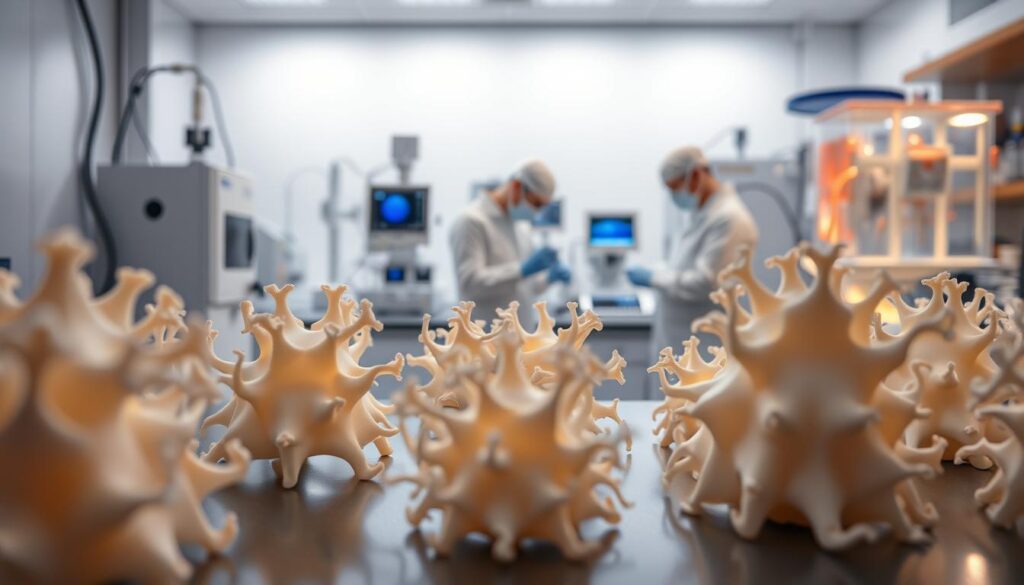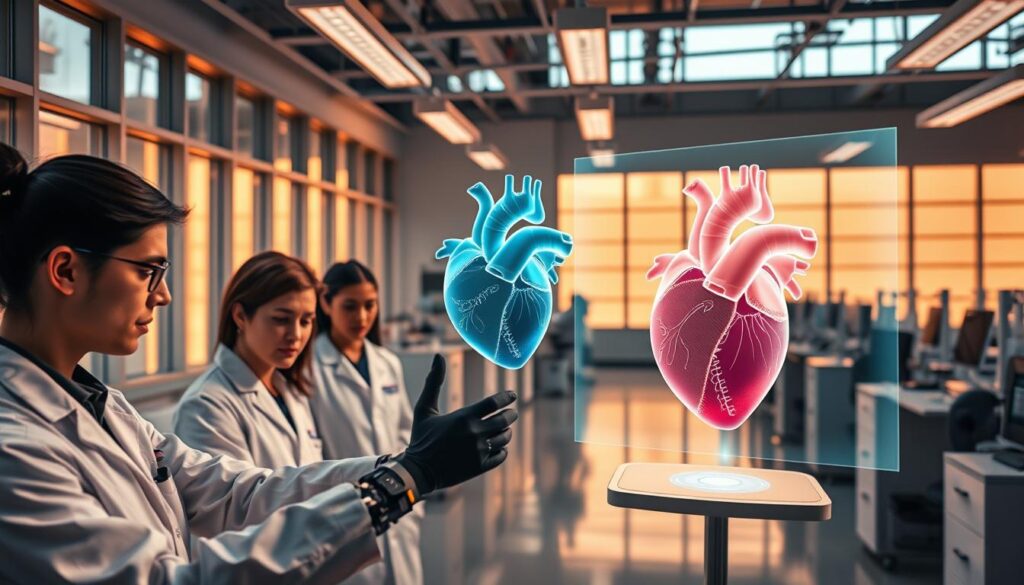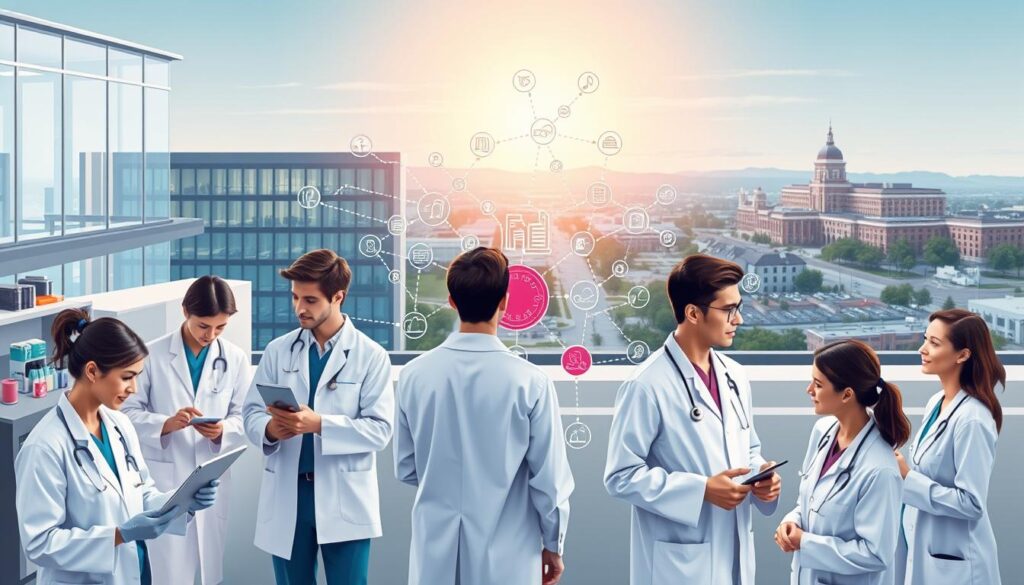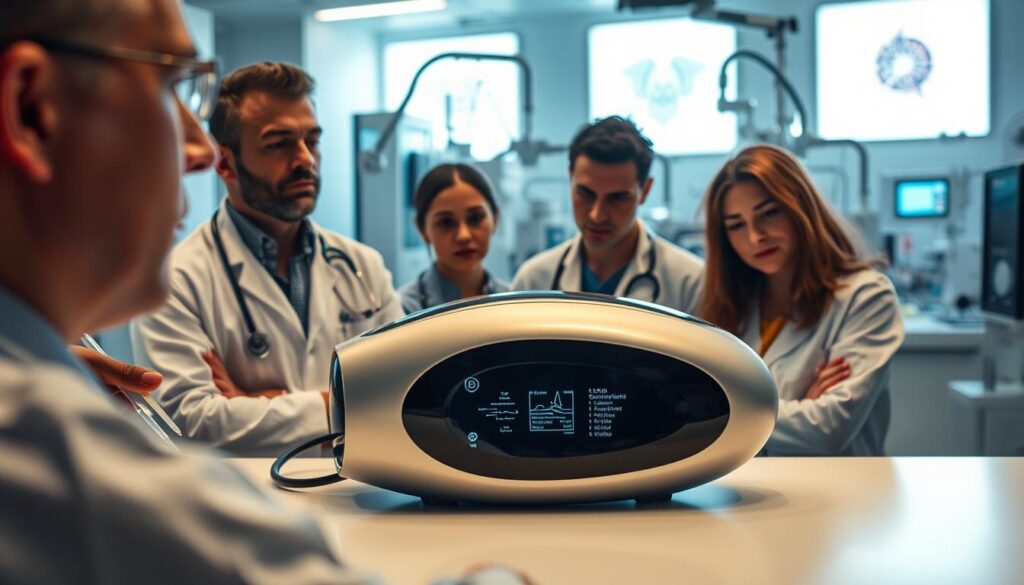Can medical technology transform patient care as we know it? The answer lies in the innovative field of biomedical engineering, where science and technology converge to revolutionize healthcare.
Biomedical engineering is at the forefront of developing cutting-edge medical solutions, from prosthetics and implants to diagnostic equipment and personalized medicine. By merging healthcare technology with medical expertise, biomedical engineers are creating a new era of patient care.
The impact of medical engineering is profound, enabling healthcare professionals to diagnose and treat conditions more effectively. As biomedical innovation continues to advance, we can expect significant improvements in patient outcomes and quality of life.
Key Takeaways
- Biomedical engineering is transforming patient care through innovative medical solutions.
- The field combines science and technology to revolutionize healthcare.
- Advances in healthcare technology are improving diagnosis and treatment.
- Biomedical engineers are creating personalized medicine and prosthetics.
- The future of healthcare is being shaped by biomedical innovation.
The Evolving Field of Biomedical Engineering (Bioengineering)
As a fusion of engineering principles and medical sciences, biomedical engineering is revolutionizing patient care. This field combines the design and problem-solving skills of engineers with the medical knowledge of healthcare professionals to develop innovative medical solutions.
Defining the Discipline and Its Scope
Intersection of Engineering and Medicine
Biomedical engineering lies at the intersection of engineering and medicine, applying engineering principles to medical devices, prosthetics, imaging techniques, and more.
Historical Development and Milestones
The field has evolved significantly since its inception, with key milestones including the development of medical imaging technologies and advanced prosthetics.
Impact on Modern Healthcare Systems
Biomedical engineering has had a profound impact on modern healthcare systems, improving diagnosis accuracy, treatment efficacy, and patient outcomes through innovative technologies such as biomedical imaging and medical devices.
| Decade | Key Developments in Biomedical Engineering |
|---|---|
| 1960s | Introduction of the first cardiac pacemakers |
| 1970s | Development of CT scan technology |
| 1980s | Advancements in MRI technology |
| 1990s | Emergence of tissue engineering |
| 2000s | Innovations in biomaterials and biomechanics |
Fundamental Principles of Biomedical Science
Understanding the fundamental principles of biomedical science is crucial for advancing medical applications and improving patient outcomes. Biomedical science is an interdisciplinary field that combines biological and physiological foundations with engineering methodologies to develop innovative healthcare solutions.
Biological and Physiological Foundations
The biological and physiological foundations of biomedical science provide the basis for understanding human health and disease. This involves studying the structure and function of living organisms, from the molecular and cellular level to entire systems. As Dr. Francis Collins, a renowned geneticist, once said, “The biggest challenge is not just understanding the genetic basis of disease, but using that knowledge to develop new therapies.”
“The biggest challenge is not just understanding the genetic basis of disease, but using that knowledge to develop new therapies.”
This foundational knowledge is critical for developing effective treatments and interventions. It encompasses understanding the complex interactions within biological systems and how they respond to various stimuli.
Engineering Methodologies in Medical Applications
Engineering methodologies play a vital role in biomedical science, enabling the development of medical devices, prosthetics, and diagnostic equipment. Biological engineering and biomechanical engineering are key disciplines that apply engineering principles to medical challenges. For instance, biomechanical engineering has led to advancements in prosthetic limbs, making them more lifelike and functional.
- Design and development of medical devices
- Biomechanical analysis of physiological systems
- Application of biomaterials in medical implants
Interdisciplinary Approach to Problem-Solving
Biomedical science thrives on an interdisciplinary approach, combining insights from biology, physiology, engineering, and bioinformatics to tackle complex healthcare challenges. This collaborative approach facilitates the development of innovative solutions, such as advanced diagnostic tools and personalized medicine strategies.
By integrating diverse disciplines, researchers and clinicians can address multifaceted problems more effectively, leading to improved patient care and outcomes. The application of biomedical applications of engineering and technology is a testament to the power of interdisciplinary collaboration.
Key Specializations in Biomedical Engineering
Biomedical engineering is a diverse field with numerous specializations that are transforming healthcare. These specializations combine engineering principles with medical knowledge to develop innovative solutions for various health-related challenges.
Biomechanics and Biomaterials
Biomechanics involves the application of mechanical principles to understand the structure and function of biological systems. Biomaterials are designed to interact with biological systems, often used in implants, prosthetics, and medical devices. The development of biocompatible materials is crucial for reducing the risk of rejection and improving the longevity of medical implants.
| Biomaterial | Application | Properties |
|---|---|---|
| Titanium | Orthopedic implants | High strength, corrosion resistance |
| Polyethylene | Joint replacement components | Low friction, wear resistance |
| Silicone | Catheters, implantable devices | Flexibility, biocompatibility |
Tissue Engineering and Regenerative Medicine
Tissue engineering and regenerative medicine focus on developing biological substitutes to restore or replace damaged tissues and organs. This field involves the use of stem cells, biomaterials, and bioactive molecules to create functional tissue substitutes.
The application of tissue engineering is seen in skin substitutes for burn victims and in the development of artificial organs for transplantation. Regenerative medicine holds promise for treating a wide range of conditions, from heart disease to spinal cord injuries.

Biomedical Imaging and Diagnostics
Biomedical imaging and diagnostics involve the use of various technologies to visualize the body’s internal structures and diagnose diseases. Techniques such as MRI, CT scans, and ultrasound are crucial for early detection and monitoring of medical conditions.
Advances in imaging technologies have improved diagnostic accuracy and enabled minimally invasive procedures. The integration of artificial intelligence in image analysis is further enhancing diagnostic capabilities.
Bioinstrumentation and Medical Devices
Bioinstrumentation involves the development of medical devices and equipment used for diagnosis, monitoring, and treatment. Examples include pacemakers, insulin pumps, and portable defibrillators.
The design of these devices requires a deep understanding of both engineering principles and clinical needs. Innovations in bioinstrumentation are improving patient care and expanding treatment options.
Neural Engineering and Brain-Computer Interfaces
Neural engineering is a specialization that focuses on the development of technologies to interact with the nervous system. Brain-computer interfaces (BCIs) enable communication between the brain and external devices, offering new possibilities for individuals with neurological disorders.
Applications of neural engineering include prosthetic control, deep brain stimulation for Parkinson’s disease, and neural implants for restoring vision. These technologies are at the forefront of restoring function and improving the quality of life for patients with neurological impairments.
Revolutionary Medical Devices and Technologies
Revolutionary medical devices and technologies are at the forefront of improving healthcare outcomes and transforming medical practices. These advancements are not only enhancing patient care but also streamlining clinical workflows and improving diagnostic accuracy.
Diagnostic Equipment Innovations
Diagnostic equipment has seen significant innovations in recent years, with a focus on improving accuracy, speed, and accessibility.
Point-of-Care Testing Devices
Point-of-care testing devices have revolutionized the way diagnoses are made, allowing for rapid testing and results in various clinical settings. Portable glucose meters and rapid HIV test kits are examples of such devices that have become indispensable in healthcare.
Wearable Diagnostic Tools
Wearable diagnostic tools are emerging as a significant trend, enabling continuous monitoring of vital signs and other health metrics. These devices are particularly useful for managing chronic conditions and detecting health anomalies early.
Therapeutic and Treatment Devices
Therapeutic and treatment devices are being developed to provide more effective and less invasive treatment options for patients.
Minimally Invasive Surgical Tools
Minimally invasive surgical tools have transformed surgical practices, reducing recovery times and improving outcomes for patients. Robotic-assisted surgery systems are a prime example of this technology.
Implantable Technologies
Implantable technologies, such as pacemakers and neurostimulators, are designed to treat a variety of medical conditions by delivering targeted therapy directly to the affected area.
Patient Monitoring Systems
Patient monitoring systems are critical for tracking patient health in real-time, especially in critical care settings. These systems enable healthcare providers to respond quickly to changes in patient condition.
| Device Type | Function | Benefits |
|---|---|---|
| Point-of-Care Testing Devices | Rapid diagnostic testing | Quick results, improved patient outcomes |
| Wearable Diagnostic Tools | Continuous health monitoring | Early detection of health issues, chronic disease management |
| Minimally Invasive Surgical Tools | Surgical procedures with less trauma | Reduced recovery time, less scarring |
Biomaterials: Building Blocks of Medical Innovation
The use of biomaterials in medical technology is opening up new avenues for the development of sophisticated medical devices and implants. Biomaterials are substances that are designed to interact with biological systems and are used in a wide range of medical applications, from prosthetics and implants to diagnostic equipment and surgical instruments.

Types and Properties of Biocompatible Materials
Biocompatible materials are crucial in medical applications as they minimize the risk of adverse reactions and ensure the longevity of medical devices. These materials can be metals, ceramics, polymers, or composites, each with unique properties that make them suitable for specific medical uses. For instance, titanium and its alloys are widely used in orthopedic implants due to their high strength, low density, and excellent corrosion resistance.
The properties of biocompatible materials, such as their mechanical strength, durability, and biocompatibility, are critical in determining their suitability for medical applications. Researchers are continually working to develop new materials with enhanced properties that can better meet the demands of various medical applications.
Applications in Prosthetics and Implants
Biomaterials play a vital role in the development of prosthetics and implants. Prosthetic limbs, for example, require materials that are not only durable but also lightweight and comfortable for the patient. Advances in biomaterials have led to the creation of more sophisticated prosthetics that can closely mimic the function and appearance of natural limbs.
Implants, such as dental implants and joint replacements, benefit from biomaterials that can integrate well with the body’s tissues, reducing the risk of rejection and improving the overall outcome of the implantation procedure. The use of biocompatible materials in these applications has significantly improved patient outcomes and quality of life.
Smart Materials and Responsive Systems
The development of smart materials represents a significant advancement in the field of biomaterials. These materials can respond to environmental stimuli, such as changes in temperature or pH, making them ideal for applications in controlled drug release and tissue engineering. Smart materials can be designed to perform specific functions, such as releasing a drug in response to a particular physiological condition.
Responsive systems based on smart materials are being explored for their potential in creating dynamic medical devices that can adapt to the needs of the patient. This area of research holds great promise for improving the efficacy and safety of medical treatments.
Biodegradable and Sustainable Solutions
Biodegradable biomaterials are designed to degrade over time, eliminating the need for additional surgeries to remove implants. These materials are particularly useful in applications such as sutures, bone scaffolds, and drug delivery systems. The development of biodegradable materials that can maintain their functionality while degrading at a controlled rate is a significant challenge.
Sustainability is also becoming a key consideration in the development of biomaterials. Researchers are exploring the use of renewable resources and designing materials that are not only biodegradable but also environmentally friendly. This shift towards sustainability is expected to have a positive impact on the environmental footprint of medical technology.
Regenerative Medicine and Tissue Engineering
Tissue engineering and regenerative medicine are at the forefront of biomedical innovation, promising to transform the future of healthcare. These interdisciplinary fields combine principles from biology, chemistry, and engineering to develop novel therapies that can repair, replace, or regenerate damaged tissues and organs.
Stem Cell Technologies and Applications
Stem cell technologies are a crucial component of regenerative medicine. Stem cells have the unique ability to differentiate into various cell types, making them invaluable for tissue repair and regeneration. Researchers are exploring the use of stem cells for treating a range of conditions, from heart disease to neurological disorders.
The applications of stem cell technologies are vast. They include the potential for regenerating damaged heart tissue, treating degenerative diseases such as Parkinson’s, and even generating insulin-producing cells for diabetes management.
Organ and Tissue Replacement Strategies
Organ and tissue replacement strategies are being developed to address the shortage of donor organs and to improve the outcomes of transplantation. Tissue engineering approaches involve creating functional tissue substitutes that can be used to replace or repair damaged tissues.
One of the key challenges in this area is developing biocompatible materials that can support the growth and function of engineered tissues. Researchers are making significant progress in this area, with promising results in the development of artificial organs and tissue substitutes.
3D Bioprinting Advancements
3D bioprinting is a rapidly advancing field that involves the use of 3D printing technologies to create complex biological structures, including tissues and organs. This technology has the potential to revolutionize the field of regenerative medicine by enabling the creation of personalized tissue substitutes.
Printed Tissues and Organs
The development of 3D bioprinting technologies is enabling the creation of complex tissues and organs that can be used for transplantation. Researchers have successfully printed functional tissues, including skin, muscle, and even organs like kidneys.
Personalized Implants
3D bioprinting also allows for the creation of personalized implants tailored to the specific needs of individual patients. This can improve the outcomes of implantation procedures and reduce the risk of complications.
Clinical Translation Challenges
Despite the significant advances in regenerative medicine and tissue engineering, there are still several challenges that need to be addressed before these technologies can be widely adopted in clinical practice. These include ensuring the safety and efficacy of new therapies, scaling up manufacturing processes, and addressing regulatory hurdles.
Overcoming these challenges will be crucial to realizing the full potential of regenerative medicine and tissue engineering. Continued research and collaboration between academia, industry, and regulatory bodies will be essential in driving these technologies forward.
Biomedical Imaging and Analysis Techniques
Biomedical imaging and analysis techniques are at the forefront of modern healthcare, providing critical information for diagnosis and treatment. These technologies have transformed the way healthcare professionals visualize and understand the human body.
Advanced Imaging Modalities
Advanced imaging modalities have significantly improved diagnostic capabilities. Techniques such as MRI (Magnetic Resonance Imaging) and CT (Computed Tomography) scans provide detailed images of internal structures.
MRI and CT Innovations
Recent innovations in MRI and CT technology have enhanced image resolution and reduced scan times. For example, high-field MRI machines offer superior image quality, while dual-source CT scanners provide faster and more accurate scans.

Molecular and functional imaging techniques, such as PET (Positron Emission Tomography) scans, allow for the visualization of metabolic processes within the body. This provides valuable information on disease progression and treatment efficacy.
Image Processing and Computational Analysis
The processing and analysis of biomedical images are crucial for extracting meaningful information. Advanced computational techniques, including image segmentation and registration, enhance image quality and facilitate accurate diagnoses.
AI and Machine Learning in Diagnostic Imaging
The integration of Artificial Intelligence (AI) and Machine Learning (ML) in diagnostic imaging has revolutionized the field. AI algorithms can analyze vast amounts of imaging data, identifying patterns and anomalies that may elude human observers.
Real-time Imaging for Surgical Guidance
Real-time imaging technologies, such as intraoperative MRI, enable surgeons to visualize the surgical site during procedures. This enhances precision and improves patient outcomes.
Bioinformatics and Computational Biology in Healthcare
Bioinformatics and computational biology are at the forefront of healthcare innovation, providing critical insights through complex data analysis. These disciplines have become indispensable in understanding and interpreting the vast amounts of data generated in medical research and practice.
Big Data Management in Medical Research
The management of big data is crucial in medical research, where vast amounts of information are generated from various sources, including genomic sequencing, clinical trials, and patient records. Effective data management enables researchers to identify patterns, correlations, and insights that can lead to new discoveries and treatments.
Key strategies in big data management include:
- Data integration: Combining data from different sources to create a comprehensive dataset.
- Data storage: Utilizing robust storage solutions that can handle large volumes of data.
- Data analysis: Applying advanced analytical tools to extract meaningful insights.
Predictive Modeling for Disease Progression
Predictive modeling is a powerful tool in healthcare, allowing clinicians to forecast disease progression and tailor treatment plans accordingly. By analyzing historical data and using machine learning algorithms, predictive models can identify high-risk patients and suggest preventive measures.
The benefits of predictive modeling include:
- Early intervention: Identifying patients at risk before symptoms appear.
- Personalized treatment: Tailoring treatment plans to individual patient needs.
- Resource optimization: Allocating healthcare resources more effectively.
Personalized Medicine Applications
Personalized medicine represents a significant shift in healthcare, moving away from a one-size-fits-all approach towards treatments tailored to individual genetic profiles and health status. Bioinformatics and computational biology play a crucial role in this field by analyzing genomic data and predicting patient responses to different treatments.
Key applications of personalized medicine include:
- Targeted therapies: Developing treatments that target specific genetic mutations.
- Genetic screening: Identifying genetic predispositions to certain diseases.
- Treatment optimization: Adjusting treatment plans based on patient response and genetic information.
Genomic and Proteomic Analysis Tools
Genomic and proteomic analysis tools are essential in understanding the complex interactions between genes, proteins, and environmental factors. These tools enable researchers to analyze large datasets and identify potential therapeutic targets.
Examples of these tools include:
| Tool | Description | Application |
|---|---|---|
| BLAST | A sequence alignment tool | Identifying homologous sequences |
| GenBank | A comprehensive genetic database | Accessing genetic information |
Rehabilitation Engineering and Assistive Technologies
Rehabilitation engineering and assistive technologies are playing a crucial role in enhancing the quality of life for people with disabilities. These innovative technologies are designed to improve mobility, restore function, and promote independence.

Mobility Enhancement Solutions
Mobility enhancement is a critical aspect of rehabilitation engineering. Advances in this area have led to the development of sophisticated devices that significantly improve the mobility and independence of individuals with physical disabilities.
Exoskeletons and Powered Prosthetics
Exoskeletons and powered prosthetics are revolutionizing the field of mobility enhancement. These wearable devices are designed to amplify or restore movement in individuals with lower limb disabilities. For instance, exoskeletons can enable individuals with spinal cord injuries to walk again.
As noted by a leading researcher, “The development of exoskeletons represents a significant breakthrough in rehabilitation engineering, offering new hope for individuals with mobility impairments.”
Smart Wheelchairs and Mobility Aids
Smart wheelchairs and mobility aids are another crucial aspect of mobility enhancement. These devices are equipped with advanced sensors and navigation systems, allowing for safer and more efficient mobility. Smart wheelchairs can detect obstacles and adjust their path accordingly, reducing the risk of accidents.
Sensory Augmentation Devices
Sensory augmentation devices are designed to enhance or restore sensory function in individuals with sensory impairments. These devices can significantly improve the quality of life for individuals with visual or hearing impairments.
Neural Interfaces for Rehabilitation
Neural interfaces are at the forefront of rehabilitation engineering, offering new possibilities for restoring function and promoting recovery. These interfaces can read neural signals, allowing individuals to control devices with their thoughts.
“Neural interfaces have the potential to revolutionize rehabilitation by enabling individuals to control prosthetic limbs and other devices with unprecedented precision.”
Telerehabilitation Systems
Telerehabilitation systems are transforming the way rehabilitation services are delivered. These systems enable healthcare providers to remotely monitor and guide patients through rehabilitation exercises, improving access to care and reducing costs.
By leveraging telerehabilitation systems, healthcare providers can offer more personalized and effective rehabilitation programs, leading to better patient outcomes.
Pharmaceutical and Biopharmaceutical Engineering
Advancements in pharmaceutical and biopharmaceutical engineering are transforming the way medications are developed and delivered. This field combines principles from engineering, biology, and medicine to create innovative solutions for improving drug efficacy and patient outcomes.
Advanced Drug Delivery Systems
Advanced drug delivery systems are crucial for enhancing the therapeutic effectiveness of medications while minimizing side effects. These systems are designed to deliver drugs in a controlled and targeted manner.
Targeted Delivery Mechanisms
Targeted delivery mechanisms involve directing drugs specifically to the diseased cells or tissues, reducing the impact on healthy parts of the body. Techniques include using nanoparticles, liposomes, and antibody-drug conjugates.
Controlled Release Technologies
Controlled release technologies allow for the gradual release of drugs over a specified period, improving patient compliance and maintaining optimal drug concentrations. Examples include biodegradable polymers and hydrogels.
Bioprocessing and Manufacturing Innovations
Bioprocessing and manufacturing innovations are vital for the efficient production of biopharmaceuticals, such as monoclonal antibodies and vaccines. Advances in cell line development, fermentation, and purification processes have significantly improved yields and reduced costs.
| Innovation | Description | Impact |
|---|---|---|
| Single-Use Bioreactors | Disposable bioreactors that reduce contamination risk and increase flexibility | Enhanced product safety and reduced capital costs |
| Continuous Processing | Continuous flow of materials through the production process | Increased efficiency and reduced production time |
| Advanced Purification Techniques | New methods for purifying biopharmaceuticals, such as membrane chromatography | Improved product purity and yield |
Vaccine Development and Production
Vaccine development and production are critical for preventing infectious diseases. Recent advancements include the use of mRNA technology, which has enabled rapid development and deployment of vaccines in response to emerging health threats.
Personalized Medication Approaches
Personalized medication approaches involve tailoring treatments to individual patients based on their genetic profiles, medical histories, and lifestyle factors. This can lead to more effective treatments and reduced healthcare costs.
Pharmaceutical and biopharmaceutical engineering are thus at the forefront of medical innovation, driving improvements in drug delivery, manufacturing, and personalized medicine. As these fields continue to evolve, we can expect significant advancements in patient care and public health.
Current Challenges and Innovative Solutions
Biomedical engineering’s impact on modern healthcare is undeniable, yet it confronts various challenges that necessitate creative problem-solving. The field, which has revolutionized healthcare through innovative medical devices and technologies, faces several obstacles that need to be addressed.
Regulatory Hurdles in Medical Device Approval
Navigating the regulatory landscape is a significant challenge. The FDA and other regulatory bodies have stringent requirements that medical devices must meet before they can be approved for market release. Ensuring compliance with these regulations while accelerating the approval process is crucial for bringing new technologies to market efficiently.
Technology Adoption Barriers
Adopting new biomedical technologies can be hindered by various factors, including cost, lack of trained personnel, and resistance to change within healthcare institutions. Addressing these barriers requires a multifaceted approach, including education, training, and demonstrating the value of new technologies.
Cost-Effectiveness and Accessibility Issues
Ensuring that biomedical innovations are cost-effective and accessible to those who need them is a significant challenge. High development costs can translate to high prices for end-users, limiting accessibility. Strategies to reduce costs without compromising quality are essential.
Interdisciplinary Collaboration Strategies
One innovative solution to these challenges is fostering interdisciplinary collaboration. By bringing together engineers, clinicians, and researchers, it’s possible to develop solutions that are both effective and practical. This collaborative approach can help in understanding clinical needs and developing technologies that meet those needs.
Bridging Research-to-Market Gaps
Another critical strategy is bridging the gap between research and market. This involves not only developing commercially viable products but also ensuring that they meet clinical needs. Effective translation of research into marketable products requires understanding both the scientific and business aspects of biomedical engineering.

In conclusion, while biomedical engineering faces several challenges, innovative solutions such as interdisciplinary collaboration and strategies to bridge research-to-market gaps can help overcome these obstacles, ultimately enhancing healthcare outcomes.
Education and Career Pathways in Biomedical Engineering
As biomedical engineering continues to shape the future of healthcare, understanding its educational and career pathways becomes increasingly important. Biomedical engineering is an interdisciplinary field that combines principles from engineering, biology, and medicine to develop innovative medical solutions.
Academic Programs and Specializations
Biomedical engineering education typically begins with a bachelor’s degree, which provides a foundation in engineering principles, biological sciences, and mathematical modeling. Many institutions offer specialized programs in areas such as biomechanics, biomaterials, and biomedical imaging.
- Biomechanics and Biomaterials
- Tissue Engineering and Regenerative Medicine
- Biomedical Imaging and Diagnostics
- Neural Engineering and Brain-Computer Interfaces
Industry Opportunities and Job Roles
Graduates in biomedical engineering can pursue a variety of career paths across different industries, including medical device manufacturing, pharmaceutical companies, and healthcare institutions. Common job roles include:
- Design and Development Engineer
- Clinical Engineer
- Regulatory Affairs Specialist
- Research Scientist

Research Careers and Innovation Pathways
For those interested in advancing the field, research careers offer opportunities to explore new technologies and methodologies. Biomedical engineers can work in academia, research institutes, or industry, driving innovation in areas such as prosthetics, implants, and diagnostic equipment.
Salary Prospects and Job Market Trends
The job market for biomedical engineers is robust, with a growing demand driven by an aging population and the need for advanced medical technologies. Salaries vary based on factors such as location, industry, and level of experience, but overall, biomedical engineers are among the higher-paid professionals in the engineering field.
Essential Skills for Future Biomedical Engineers
To succeed in this field, biomedical engineers need a combination of technical skills, including programming, materials science, and data analysis, as well as soft skills such as teamwork, communication, and problem-solving. Staying updated with the latest technological advancements and regulatory requirements is also crucial.
In conclusion, biomedical engineering offers a rewarding career path with diverse opportunities for education, research, and industry applications. By understanding the educational pathways and career opportunities available, individuals can better prepare themselves for a successful career in this dynamic field.
Ethical Considerations in Biomedical Innovation
Biomedical innovation is not just about technological advancement; it’s also about navigating the complex ethical landscape. As biomedical engineering continues to evolve, it brings forth a myriad of ethical considerations that must be addressed to ensure that these innovations benefit society as a whole.

Patient Safety and Risk Management
One of the primary ethical considerations in biomedical innovation is patient safety. Ensuring that new medical devices, technologies, and treatments are safe for use is paramount. This involves rigorous testing and risk management strategies to mitigate potential harm to patients.
The use of biocompatible materials and strict regulatory compliance are critical in minimizing risks associated with biomedical innovations.
Privacy and Data Security Concerns
Biomedical innovations often involve the collection and analysis of sensitive patient data. Ensuring the privacy and security of this data is an ethical imperative. This includes implementing robust data protection measures and complying with regulations such as HIPAA.
Healthcare providers must balance the benefits of data-driven medicine with the need to protect patient confidentiality.
Accessibility, Equity, and Global Health
Another crucial ethical consideration is ensuring that biomedical innovations are accessible to those who need them, regardless of their geographical location or socio-economic status. This involves addressing issues of equity and global health.
Efforts to make biomedical innovations more accessible can include low-cost manufacturing and partnerships with global health organizations.
Emerging Ethical Dilemmas in Biotechnology
The rapid advancements in biotechnology are giving rise to new ethical dilemmas. Issues such as gene editing and synthetic biology raise questions about the boundaries of scientific intervention and the potential consequences for humanity.
| Ethical Dilemma | Description | Potential Impact |
|---|---|---|
| Gene Editing | Altering genes to prevent or treat diseases | Potential for curing genetic diseases but raises concerns about eugenics |
| Synthetic Biology | Designing new biological systems or organisms | Potential for new medical treatments and biofuels but raises concerns about unintended consequences |
Global Impact and Regional Developments
The global impact of biomedical engineering is evident in its regional advancements, transforming healthcare systems worldwide. As biomedical engineering continues to evolve, different regions are contributing uniquely to its growth and development.

North American Research and Industry Landscape
North America, particularly the United States, is a leading hub for biomedical engineering research and innovation. The region is home to numerous top-ranked universities and research institutions, driving advancements in medical technology and devices. According to a report by the National Science Foundation, the U.S. accounted for a significant portion of global R&D expenditures in 2019, highlighting its commitment to biomedical research.
Innovations in biomedical engineering in North America include the development of advanced prosthetics, implantable devices, and diagnostic equipment. Companies like Medtronic and Boston Scientific are at the forefront of these innovations, pushing the boundaries of what is possible in healthcare.
European Regulatory Framework and Innovations
Europe plays a crucial role in shaping the global biomedical engineering landscape through its rigorous regulatory frameworks and innovative research environment. The European Union’s Medical Device Regulation (MDR) has set new standards for the safety and efficacy of medical devices, influencing global industry practices.
“The EU’s MDR represents a significant step forward in ensuring patient safety and promoting innovation in the medical technology sector.” – Industry Expert
European countries are also known for their contributions to biomedical engineering, with institutions like the University of Oxford and ETH Zurich leading research in areas such as tissue engineering and regenerative medicine.
Asian Technology Hubs and Manufacturing
Asia has emerged as a significant player in biomedical engineering, with countries like China, Japan, and South Korea investing heavily in research and manufacturing. The region’s technology hubs are driving innovation in areas such as robotics, AI, and biotechnology.
China’s rapid growth in the biomedical sector is noteworthy, with the government implementing policies to support the development of high-tech industries. This has led to significant advancements in medical device manufacturing and export.
Emerging Markets and Healthcare Needs
Emerging markets present both challenges and opportunities for biomedical engineering. Countries in regions such as Latin America, Africa, and Southeast Asia have diverse healthcare needs, often requiring innovative and affordable solutions.
Local companies in these regions are developing products tailored to their specific healthcare challenges, such as low-cost diagnostic tools and portable medical devices. International collaborations are also playing a crucial role in addressing these needs.
International Collaboration Initiatives
International collaboration is vital in biomedical engineering, enabling the sharing of knowledge, resources, and expertise across borders. Initiatives such as the Human Genome Project and global health organizations like the World Health Organization (WHO) exemplify the power of international cooperation.
These collaborations not only accelerate innovation but also help address global health disparities by making advanced medical technologies more accessible.
Future Trends and Emerging Technologies
The future of biomedical engineering is being shaped by emerging technologies that promise to revolutionize healthcare. These advancements are not only improving existing medical practices but also opening up new avenues for research and treatment.
Nanotechnology in Diagnostics and Therapeutics
Nanotechnology is playing an increasingly important role in biomedical engineering, particularly in diagnostics and therapeutics. Nanoparticles are being designed to target specific cells or tissues, allowing for more precise drug delivery and imaging.
- Enhanced drug delivery systems
- Improved diagnostic accuracy
- Targeted therapy with minimal side effects
Genetic Engineering and Gene Therapy Applications
Genetic engineering and gene therapy are emerging as powerful tools in the treatment of genetic disorders. By modifying or replacing defective genes, scientists are working towards new treatments for previously incurable conditions.
- Gene editing technologies like CRISPR
- Gene therapy for inherited diseases
- Potential for treating complex conditions
AI and Machine Learning Integration
The integration of Artificial Intelligence (AI) and Machine Learning (ML) in biomedical engineering is enhancing data analysis, diagnosis, and treatment planning. AI algorithms can analyze vast amounts of medical data to identify patterns and predict outcomes.
Wearable and Remote Healthcare Solutions
Wearable devices and remote healthcare solutions are revolutionizing patient monitoring and care. These technologies enable continuous health monitoring and timely interventions.
- Wearable biosensors
- Remote patient monitoring systems
- Telehealth services
Quantum Computing Applications in Biomedical Research
Quantum computing has the potential to significantly accelerate biomedical research by analyzing complex data sets more efficiently than classical computers. This could lead to breakthroughs in understanding diseases and developing new treatments.
Sustainable and Green Biomedical Technologies
The development of sustainable and green biomedical technologies is crucial for reducing the environmental impact of medical practices. This includes biodegradable medical devices and eco-friendly manufacturing processes.
As biomedical engineering continues to evolve, the integration of these emerging technologies will be key to shaping the future of healthcare. By embracing innovation and sustainability, the field can address current challenges and improve patient outcomes.
Conclusion: The Transformative Potential of Biomedical Engineering
Biomedical engineering is revolutionizing healthcare by developing innovative medical solutions and improving patient care. The field’s transformative potential lies in its ability to merge engineering principles with medical knowledge, creating cutting-edge technologies that enhance diagnosis, treatment, and rehabilitation.
The impact of biomedical engineering is evident in the development of advanced medical devices, biomaterials, and imaging technologies. These innovations have improved patient outcomes, streamlined clinical workflows, and reduced healthcare costs. As biomedical engineering continues to evolve, we can expect to see even more groundbreaking technologies emerge, such as nanotechnology and genetic engineering applications.
The future of healthcare innovation relies heavily on the continued advancement of biomedical engineering. By fostering collaboration between engineers, clinicians, and researchers, we can unlock new medical technology solutions that transform patient care and improve quality of life. The transformative potential of biomedical engineering is vast, and its continued growth will be crucial in shaping the future of healthcare.
